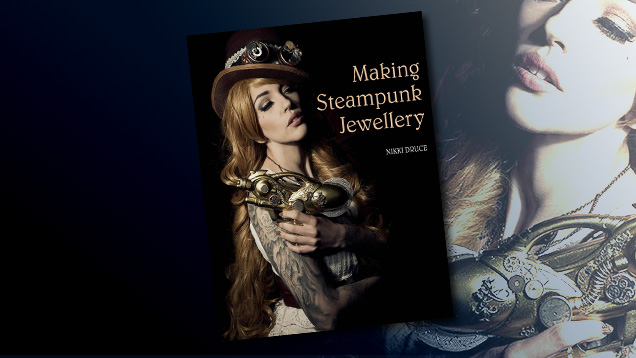Book Review: Making Steampunk Jewellery
March 5, 2018

Steampunk is a genre of literature that has become a subcultural movement and has made its way into movies, comic books, music, art, and fashion. Its roots partially derive from the books of H.G. Wells and Jules Verne as a Victorian take on futurism, a world where steam-powered inventions are at the cutting edge of technology. The term “steampunk” was said to have been coined by author K. W. Jeter in the mid-1980s, and the movement gained prominence in the early 1990s. There are subgenres to steampunk, including clockpunk, boilerpunk, and decopunk. Each subgenre draws inspiration from different eras and social classes and, in turn, influences related literature and fashion. While some genres are darker and gothic in tone (dieselpunk), and others are more ethereal and inspired by fairy tales (dreampunk), the predominant steampunk fashion style is based on clothing from the Victorian era with retro-futuristic embellishments and accessories. Certain style elements are common to many of the subgenres: gears, cogs, goggles, watch parts, and ray guns, but there are no hard and fast rules for how one should dress as a steampunk. It is a fantasy world, after all.
Nikki Druce, a London-based designer and self-described “maker” of steampunk-inspired jewelry and owner of an online shop called “Devine Delinquents,” wrote Making Steampunk Jewellery for jewelry-making novices and for newer aficionados of steampunk. Druce is a self-taught jewelry maker who started making pieces for her own adornment; what started out as a hobby turned into a full-fledged business. The resulting jewelry and accessories were well-received and with this book, she shares her experience and skills to instruct readers on how to create their own pieces.
The book is organized into nine chapters, beginning with basic information about steampunk, the equipment and materials needed to create jewelry, and design inspirations. It then breaks out into sections with categories of more than 25 projects: necklaces, brooches/pins and rings, headgear, and other accessories. One fun and easy project is the ray gun necklace, which requires a small squirt gun, some acrylic paint, jewelry findings, and gears or watch parts. Each project (or tutorial, as Druce calls them) is pretty straightforward, with step-by-step instructions for creating fairly simple pieces. She encourages readers to use the tutorials as starting points to build on their own creativity. At the beginning of each project, she has a photo of the finished piece; she also lists the materials and tools needed with accompanying photos. Each step also has its own accompanying photo. Although most of the projects are accessories worn by women, Druce does include a chapter on men’s steampunk projects, titled “The Captain of the Airship.” A wardrobe staple of the well-dressed steampunk gent is a top hat. One of the projects in this section is a top hat band that can add versatility to the hat. With elastic headbands, ribbon, felt, feathers, and a few decorative items like watch parts or gears, you can easily create several different hatbands to change the look. Another project for men is the jabot, a detachable decorative item of clothing that attaches to the front of a shirt. It has layers of fabric in waves and is usually decorated with a cameo, beads, or lace. This project requires a little more effort, but adds a touch of elegance to an outfit.
In the final chapter, the author provides advice on how to put together a complete outfit without spending a lot of money. Upcycling, taking old clothing and repurposing it to make something better than the original, is one way to save money. Druce also writes about commonly used fabrics, hair styling tips, and adding corsets, harnesses and bustles to create a costume with a look of authenticity.
In the back of the book, Druce provides further information on resources that may be of interest to further your knowledge of steampunk and a list of suppliers for steampunk items and clothing. Most of the suppliers listed seem to be based in the United Kingdom.
This book is well-organized, easy to follow, and nicely illustrated throughout, with photos of models in steampunk attire wearing the finished accessories. The projects require just a few basic tools, inexpensive supplies, and minimal crafting skills. It is a good book to aid someone through an initial foray into the world of steampunk.
Judy Colbert is manager of the Visual Resources Library at GIA in Carlsbad, California.



